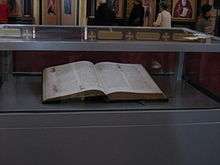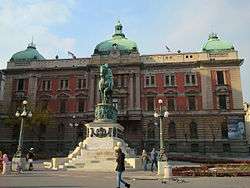Miroslav Gospel
Miroslav's Gospel (Serbian: Мирослављево Јеванђеље / Miroslavljevo Jevanđelje, pronounced [mǐrɔslaʋʎɛʋɔ jɛʋǎndʑɛːʎɛ]) is a 362-page illuminated manuscript Gospel Book on parchment with very rich decorations. It is one of the oldest surviving documents written in the Serbian recension of Church Slavonic. The gospel is considered a masterpiece of illustration and calligraphy.[1]
| Miroslav's Gospel | |
|---|---|
 First two pages of the manuscript | |
| Created | 1186 |
| Location | National Museum of Serbia, Belgrade |
| Author(s) | Grigorije the Pupil |

Origin and discovery
Miroslav's Gospel was commissioned in the 12th century (in the year 1186) by Miroslav, the ruler (knez) of Hum[2] and the brother of Stefan Nemanja, the Grand Prince of Rascia. The first to discover and study the manuscript were three Russian scholars: Vladimir Stasov, Fyodor Buslayev, and Nikodim Kondakov in 1874.
A leaf of the book which the Archbishop Porphyrius Uspensky had cut out of the book from the Hilandar Monastery library in 1845 was first publicly shown at an exhibition in Kiev in 1874.[3] The earliest facsimile edition appeared in Vienna in 1897. The book was traditionally kept at the Hilandar Monastery on Mount Athos, before it was presented to King Alexander I of Serbia, on the occasion of his visit to the monastery in 1896. Today it is in the collection of the National Museum of Serbia in Belgrade.
The book was originally transcribed in Kotor in modern-day Montenegro between 1186 and 1190 from an earlier text. Most pages are by an unknown scribe from Zeta, with the last few pages written by the scribe Grigorije of Raška, also known as Grigorije the Scribe or Pupil. Although Miroslav's Gospel is one of the earliest Cyrillic-texted manuscripts, the document appeared later than other Serbian liturgical manuscripts written in Glagolithic.[4] The language used is considered unique as it showed the transition between Old Church Slavonic and the first recognizably distinct Serbian language.[1]
In 2005, the Miroslav Gospel was inscribed in UNESCO's Memory of the World Register in recognition of its historical value.[5]
See also
- Medieval Serbian literature
- Serbian manuscripts
- John the Deacon
- Teodosije the Hilandarian (1246-1328), one of the most important Serbian writers in the Middle Ages
- Elder Grigorije (fl. 1310-1355), builder of Saint Archangels Monastery
- Antonije Bagaš (fl. 1356-1366), bought and restored the Agiou Pavlou monastery
- Lazar the Hilandarian (fl. 1404), the first known Serbian and Russian watchmaker
- Pachomius the Serb (fl. 1440s-1484), hagiographer of the Russian Church
- Grigorije the Scribe, author of Miroslav Gospel
- Grigorije of Gornjak
- Gabriel the Hilandarian
- Constantine of Kostenets
- Cyprian, Metropolitan of Kiev and All Rus'
- Gregory Tsamblak
- Isaija the Monk
- Elder Siluan
- Atanasije (scribe)
- Rajčin Sudić
- Jakov of Serres
- Romylos of Vidin
- Marko Pećki
References
- Deliso, Christopher (2008). Culture and Customs of Serbia and Montenegro. Westport, CT: Greenwood Publishing Group. p. 102. ISBN 9780313344367.
- Cuvalo, Ante (2007). The A to Z of Bosnia and Herzegovina. Lanham, MD: The Scarecrow Press, Inc. p. 155. ISBN 9780810876477.
- "NLR.ru". Archived from the original on 2014-03-01. Retrieved 2010-01-31.
- Casiday, Augustine (2012). The Orthodox Christian World. Oxon: Routledge. p. 537. ISBN 9780415455169.
- "Miroslav Gospel – Manuscript from 1180". UNESCO Memory of the World Programme. 2014-01-19. Retrieved 2009-12-14.
Further reading
- Dušan Mrđenović; Veljko Topalović; Vera Radosavljević (2002). Miroslavljevo jevanđelje: istorijat i komentari. Dosije.
